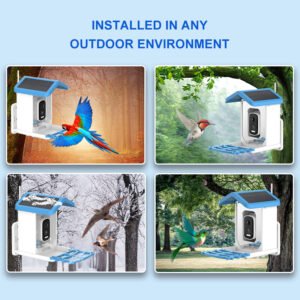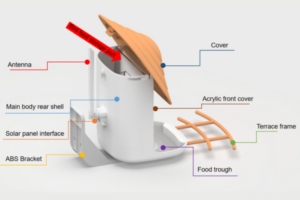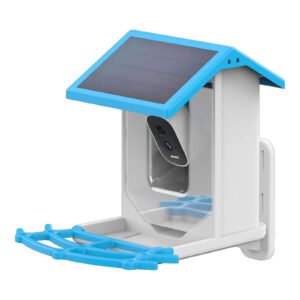Many people want to feed birds but don’t have the time or resources to build complex bird feeders. This often leads to missed opportunities for helping local wildlife thrive. The good news is that creating a pinecone bird feeder is simple, affordable, and a fun way to attract birds to your garden. Read on to learn how you can make your own pinecone bird feeder in just a few easy steps.
Making a pinecone bird feeder is simple and fun! Follow this guide to help local birds thrive by providing them with food in your backyard.
If you’re ready to start crafting your pinecone bird feeder, let’s dive into the step-by-step process below. We will cover everything from how to make it, to answers to common questions like whether pinecone bird feeders work and how to avoid using peanut butter.
How Do You Make a Pinecone Bird Feeder?
Making a pinecone bird feeder is incredibly simple and requires only a few materials. Here’s how to do it step by step:
- Gather your materials: You’ll need pinecones (the larger, the better), birdseed, a string (optional), and a binding agent like peanut butter or coconut oil.
- Prepare the pinecone: If your pinecone has any excess dirt or debris, gently clean it by brushing it off. You can also let it sit in the sun to help it open up fully.
- Apply the binding agent: Use a butter knife or spoon to spread your chosen binding agent (such as peanut butter, coconut oil, or lard) onto the surface of the pinecone. Ensure that it’s well-coated, filling in all the nooks and crannies.
- Coat the pinecone with birdseed: Once the pinecone is coated in the binding agent, roll it in birdseed or press the seeds into the crevices. You can use a variety of seeds, depending on the types of birds you want to attract.
- Hang your feeder: Tie a piece of string to the top of the pinecone if you want to hang it from a tree. Otherwise, you can place the pinecone directly on a flat surface or in a bird feeder tray.
- Place it in a good spot: Hang the pinecone feeder in an area visible to birds, preferably near trees or bushes where they can feel safe.
By following these simple steps, you’ll have a functional bird feeder that can last for weeks.
Do Pinecone Bird Feeders Work?
Yes, pinecone bird feeders work great for attracting a wide variety of birds. Birds love the natural texture of pinecones and can easily cling to them while feeding. They are a fantastic way to provide food for birds during colder months when natural food sources may be scarce.
Pinecone bird feeders offer a convenient, easy-to-make solution that can cater to many types of birds. They are especially useful in backyard environments where larger, more complex feeders may not be practical.
How Do You Make Pinecones Safe for Birds?
To make pinecones safe for birds, it’s essential to avoid harmful substances that could harm them. If you’re using pinecones from your yard, ensure they haven’t been exposed to pesticides or harmful chemicals.
When making your bird feeder, opt for organic binding agents like peanut butter or coconut oil. Always check the ingredients of store-bought peanut butter to avoid additives like sugar or salt, which can be harmful to birds.
Additionally, be cautious of using sharp pinecone scales that might cause injury to birds. Consider trimming any jagged edges before using the pinecone.
How to Make Bird Feeders with Pine Cones Without Peanut Butter?
If you’re looking to make a pinecone bird feeder without peanut butter, don’t worry! There are several alternatives to this common binding agent.
- Coconut oil: This is an excellent option for a bird-safe binding agent. It has a high fat content, which birds love. Plus, it doesn’t have the same potential allergens as peanut butter.
- Lard: A traditional choice for making bird feeders, lard provides the necessary fats for birds during cold weather.
- Suet: Suet cakes are another fantastic alternative that birds will happily peck at. Suet can be pressed into the crevices of the pinecone as an alternative to peanut butter.
These alternatives can help you create a bird-friendly pinecone feeder without worrying about peanut butter allergies or sensitivities.
What is a Substitute for Peanut Butter in a Bird Feeder?
If you’re looking for a safe and effective substitute for peanut butter in a bird feeder, consider the following options:
- Coconut oil: Rich in fat, coconut oil is a bird-friendly option.
- Lard or tallow: These fats are great for keeping birds well-fed during the winter months.
- Vegetable shortening: A non-dairy option that works well as a binding agent.
Each of these alternatives offers the necessary fats for birds, making them just as effective as peanut butter.
Can You Use Honey to Make a Pine Cone Bird Feeder?
Honey is not a good option for making pinecone bird feeders. While it’s natural and sweet, it can attract unwanted insects like ants and bees. Additionally, honey can harden over time, making it difficult for birds to feed.
Stick with fat-based binding agents like peanut butter, coconut oil, or suet for a bird-friendly and lasting feeder.
Can You Use Cinnamon-Scented Pine Cones for Bird Feeders?
While cinnamon-scented pinecones may smell pleasant to us, they are not ideal for bird feeders. Birds are sensitive to certain scents, and strong fragrances like cinnamon could deter them from visiting your feeder. It’s best to use unscented pinecones to ensure that birds are attracted to the food source rather than the smell.
Conclusion
Making a pinecone bird feeder is a simple and rewarding way to support local wildlife. Whether you use peanut butter, coconut oil, or suet, the process is easy to follow, and the results are sure to attract a variety of birds to your backyard.






